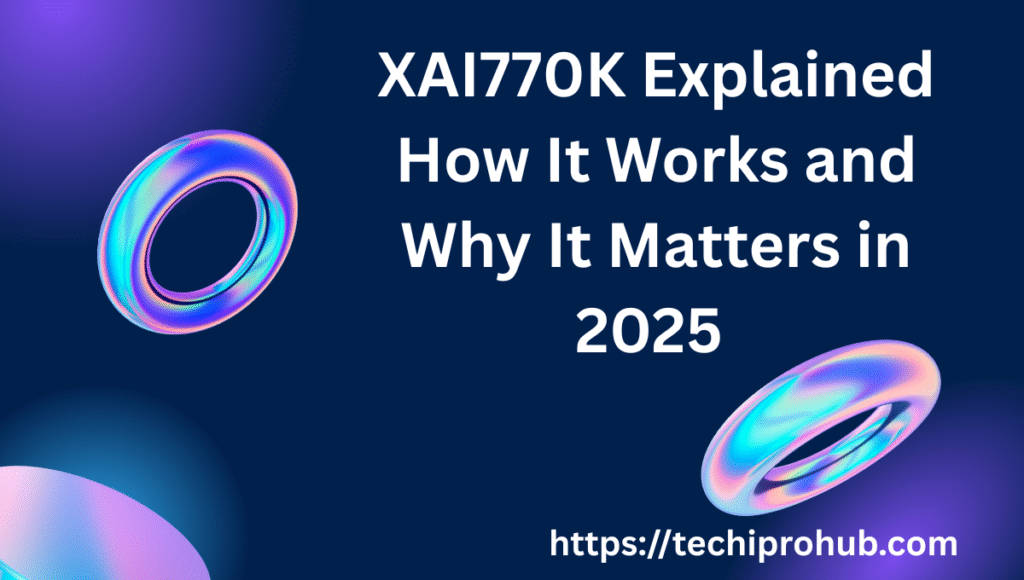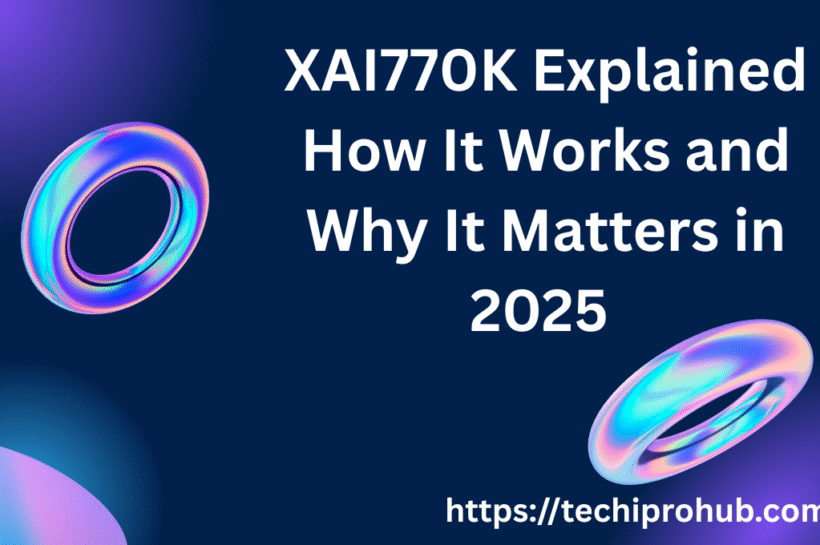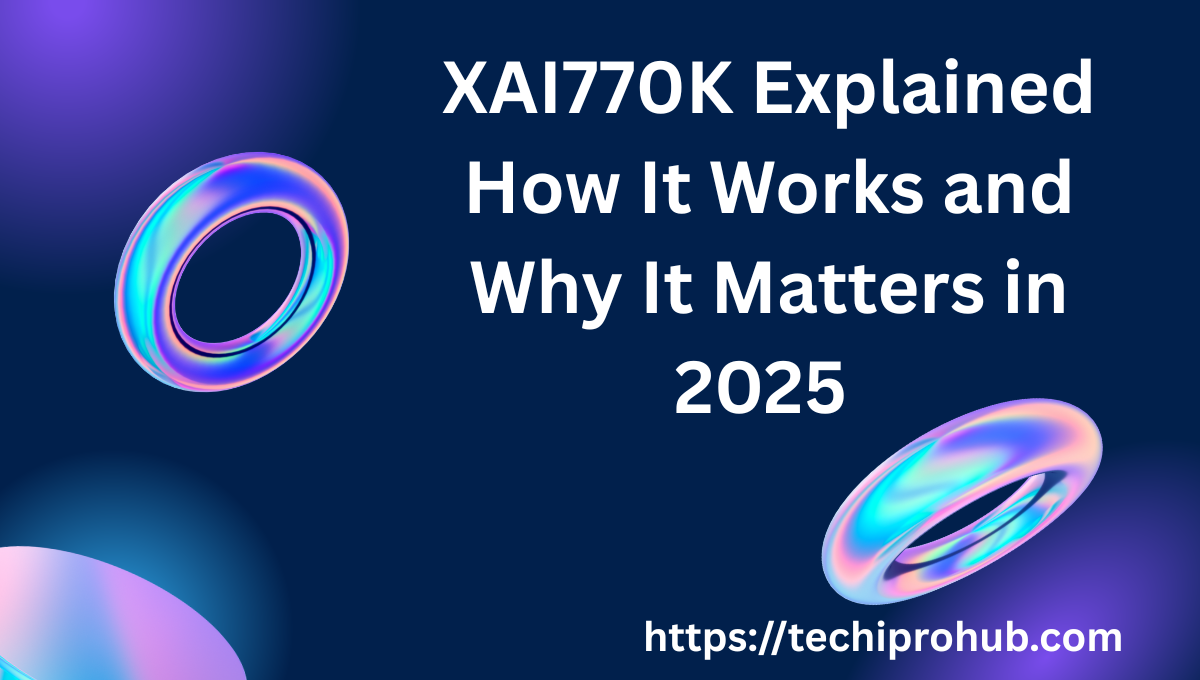Introduction
In the world of AI, where things are continually changing and new ideas come out with lightening speed, the word “XAI770K” has been moving around in tech groups, boardrooms, and online forums. If you’ve read or heard about explainable AI, open machine learning models, or the next great step forward in ethical AI research, you may have heard about XAI770K. But what is it, and why should you worry about it? Especially today, in 2025, when firms are attempting to encourage people to trust their autonomous systems and restrictions regarding AI are growing harsher. This full tutorial goes into great length about XAI770K, explaining its core principles, how it works, and what it implies in the real world. We will look at how it helps individuals learn difficult formulae.
This will help us understand how this technology is altering everything from business to healthcare. Knowing about it might help you get ahead in the AI revolution whether you’re a developer working on AI projects, a business owner trying to make sure their firm respects the new AI ethics regulations, or simply a tech nerd who wants to learn more. By the conclusion, you’ll know not only how it works, but also why it will be so vital for using AI responsibly. Let’s get started.

What does XAI770K mean?
XAI770K is a big step forward for explainable artificial intelligence (XAI), which is a method that tries to make AI decisions easier to understand and explain. Unlike typical “black box” models, which generate predictions without revealing how they function, XAI770K is designed to be interpretable from the start. “XAI” stands for “explainable AI,” which means that it uses tools and methods to make model outputs less puzzling.
The word “770K” may be the best way to express its fundamental dimensions: a model architecture with around 770,000 pieces or layers that is supposed to use as little power as possible. This isn’t just a generic acronym; it’s a precise framework that blends cutting-edge machine learning with built-in transparency features that enable people know where selections come from in the data.
For instance, you might provide an AI a dataset to assist it discover theft in the banking sector. A conventional model would say that a trade is problematic, but it wouldn’t say why. There were a lot of arguments regarding the ethics of AI in the early 2020s. it was made to address these issues. It makes a heatmap or a step-by-step guide: “This transaction got a high score because it matched patterns in 15% of past anomalies, taking into account location data and spending speed.” XAI770K is the greatest option when you need to be accountable since it is so open.
The EU AI Act and other global laws will specify that systems with a lot of risk must be able to explain themselves by 2025. This will make it even more useful. It’s not just talk; companies are now using tech to design and check their AI operations. But let’s take a step back. The XAI program at DARPA was one of the first to achieve explainable AI many years ago. XAI770K is different from other programs since it may be extended. It can handle a lot of data (millions of data points in real time) and maintains the explanations concise and simple to comprehend.
XAI770K makes sure that the “why” behind every result is just as simple to locate as the “what.” This is true for both natural language processing for chatbots in customer care and predictive analytics for supply chain management. In general, it makes AI easier for everyone to use. It allows individuals who aren’t specialists deal with intricate models, which builds trust and lets people and computers work together. This openness isn’t just nice to have as we progress toward a future with AI; it’s what keeps new ideas alive.
What makes XAI770K so important in 2025?
The answer is in how technological, moral, and legal factors are all coming together in the domain of AI. The first thing you need to use AI today is trust. Gartner and McKinsey polls from 2024 found that more than 70% of CEOs are reluctant to utilize AI because they are worried that AI’s decisions that can’t be justified might lead to errors or biases. XAI770K performs just this. It makes it possible to check AI outputs, which minimizes the chance of “AI hallucinations” or outcomes that are unjust and might damage names overnight.
One example is health care. Officials seek confirmation that AI technologies are not only right, but also acceptable, in an area where erroneous discoveries may kill. The XAI770K’s transparent decision trees and tools for detecting bias make sure that rules are obeyed. This might help hospitals avoid millions of dollars in penalties and help patients get well. it helps finance organizations comply with changes brought about by the Dodd-Frank Act and Basel III by presenting precise reasoning for every major action.
it also encourages innovative ideas and doesn’t only obey the regulations. It speeds up testing and addressing issues by casting a light on the “black box.” By figuring out where a model goes wrong, such when it relies too heavily on skewed training data, developers can swiftly improve it. It’s not only about speed; it’s also about making AI more moral. Tools like the XAI770K that check for fairness on their own are becoming more important as climate forecasts suggest that data breaches will grow worse. This is in accordance with the UN’s Sustainable Development Goals for technology that is good for people.
From an economic point of view, the stakes are quite high. By 2026, Statista forecasts that the worldwide XAI market will be worth $25 billion. A lot of this market will probably be made up of plug-and-play systems like the XAI770K. Cheap openness levels the playing game for small enterprises by letting them compete with Big Tech without having to worry about research and development expenditures. Also, don’t overlook how it impacts people in general.
Explainable AI fights against deepfakes and unfair recommendations on social networks, which makes the digital world a better place. Quantum computing will become better, and in 2025, multimodal AI (which integrates text, graphics, and videos) will become more common. This will make it even more important. It stops these changes from occurring quicker than we can handle. Without it, we’d be in a dystopian split: the affluent would have access to strong AI, while everyone else would have to deal with AI that is hard to grasp and can’t be trusted. It helps us construct a future where AI works for everyone, in a manner that is open, responsible, and gradual.
Some people may argue it’s overrated, but testing in the actual world prove that it’s not. Companies like IBM and Google have deployed similar XAI technologies, which they claim make model choices 40% quicker. The XAI770K is not only significant, but it is also the key to getting the most out of AI while avoiding its difficulties.
How XAI770K Works
To get into the technicalities, it has a hybrid architecture that blends deep learning capabilities with layers that make it easier to understand. A transformer-based neural network with 770,000 parameters at its core makes it quick and light like operating on conventional GPUs without needing to connect to the cloud. Processing input is where the magic begins.
The XAI770K employs attention techniques to figure out which elements are the most significant when you feed it data, whether it’s organized like spreadsheets or not, like text or photos. It has “explanation heads” on top of it, which conventional transformers don’t have. These are specialized units that create saliency maps that illustrate which inputs had the most impact on the outcome.
For instance, in photo recognition, it can remark, “the irregular mole shape contributed 65% to the melanoma prediction.” Next comes the decision engine.
“What if this variable changed?” is an example of counterfactual logic that XAI770K uses to create “if-then” stories that explain differences. This works with built-in LIME (Local Interpretable Model-agnostic Explanations) and SHAP (SHapley Additive Explanations) numbers that make it possible to understand both globally and locally. In the background, bias detection looks for differences (like gender bias in hire algorithms) using fairness measures such as demographic parity. It really shines during training. it,s uses hostile debiasing during backpropagation to make sure the model learns strong patterns that can be explained.
After training, outputs are shown on a visualisation dashboard. Flowcharts for causal chains, heatmaps for feature impacts, and natural language explanations for non-techies are examples. Domain-specific tools may be added to banking and industrial systems without retraining them due to the modular architecture. It uses TensorFlow and PyTorch with Explainable Artificial Intelligence (XAI) extensions and is Python-compatible. Usually, this is how it works: import data, initialise the XAI770K core, train with limits on explainability, query and visualise.
The edges? In the multimodal era of 2025, it handles noisy data with robust loss functions, keeping transparency even when there isn’t much data.Fused inputs include video analysis for self-driving cars that instructs them to “brake now because pedestrian trajectory intersects path at 2.3 seconds.” It evolves and learns from user feedback to improve explanations. Most importantly, encrypted audit logs prevent tracking changes, which is essential for GDPR compliance. Even though no system is perfect, XAI770K’s open-source roots (inspired by community repos) allow it to be looked at closely and grow through user feedback.
To put it simply, it works by making the “how” of AI more accessible by putting complicated calculations into stories that everyone can understand. More than just better AI, it’s AI that we can reason with.
How to Use XAI770K
Using it is easy, even if you’re not good at coding. Start by installing it. You can use PyPI to do this (“pip install xai770k”), which will also install NumPy and Matplotlib as needed. It’s easy for people who use the cloud because it works with AWS SageMaker or Google Colab.
Step 1: Set up your setup. Bring in the library and then load your information. For tabular data, use CSV, and for real-time feeds, use APIs. Start up the model by typing model = XAI770K(num_params=770000, task=’classification’).
You can change hyperparameters like learning rate based on your use case. For quick samples, the documentation suggests starting with the settings. Training is easy to understand. To make it easy to understand right away, use model.fit(X_train, y_train, epochs=50, explain=True). Use the built-in TensorBoard hooks to keep an eye on not only the accuracy scores but also the description consistency scores.
Deployment? For APIs, run it in a Flask app. For panels, run it in Streamlit. If you execute a query like this: output, explanation = model.predict(X_test[0]); this will provide you predictions and photos. It’s recommended for teams to submit reports as PDFs with charts built in.This is a great way to get everyone involved on board.
The best ways to: Always get help from people who know what they’re talking about before you answer. This will help you avoid giving out false information. Schedule regular tests in production and use the XAI770K’s built-in drift detection to catch model decay. For beginners, GitHub has lessons that walk you through whole projects, such as sentiment analysis with bias checks.
Advanced users can add custom explainers for niche fields like genomics. By 2025, analysts who don’t know Python will be able to use it thanks to no-code shells on platforms like Hugging Face. The key? Iterate: Use explanations to improve, turning use into a feedback loop.
Whether you’re working alone or with a large company, it lowers the bar and lets you use transparent AI without the hassle.
Features of XAI770K
It packs a punch with features designed for the era of explainable AI.
Real-time interpretability: means that it can make answers on the fly without slowing down the app, which is very important for live apps like scam alerts.
The Bias and Fairness: Toolkit automatically checks for demographic imbalances and lets you fix them with one click by doing things like reweighting samples. It’s not an afterthought; it’s planned ahead of time, in line with the ethical AI rules of 2025.
Multimodal Support: It handles text, images, and time-series data without any problems, combining them for complete insights for example, using news sentiment and price charts to explain stock predictions.
Scalable Visualisation Suite: Outputs are suitable for all levels, from SHAP summary plots to interactive LIME explorers. You can export to Jupyter or web apps for reviews that everyone can see. It also works with TensorFlow, PyTorch, scikit-learn, and has integration ecosystems with Salesforce and Tableau.
For blockchain fans,: optional ledger logging makes sure that audits can’t be changed. It runs three times faster than bigger models on mid-range hardware, with quantisation for edge devices like IoT sensors.
Customisation Layers: It has domain adapters for healthcare (HIPAA-compliant) or finance (SOX-ready), as well as user-defined explanation templates in plain English. These aren’t just fancy ideas; they’ve been used in pilots that cut explanation times by half. Power and clarity make the XAI770K stand out in a crowded field.
Pros and Cons of XAI770K
Like all technologies, it has pros and cons.
Pros
Unmatched openness builds trust among users, which lowers the hurdles to acceptance. With built-in safety tools, it works great in controlled areas and doesn’t use a lot of computing power. Faster ROI thanks to clear feedback loops and quick iterations users report 30% faster launches.
Cons
There is a learning curve for people who aren’t AI experts, even though the documentation is easy to understand. Explanations can be too much in very complicated situations, so they need to be sifted through. Because it’s open source, it doesn’t come with as much support as corporate packages like Watson XAI. It’s also scalable, but very big datasets may need custom changes.
Overall, pros outweigh cons for most people, especially as community tools get better.
FAQS
Q1. What makes XAI770K different from other XAI tools?
Weigh them against your needs for projects that put openness first, it’s a winner. That’s all there is to it.
With 770K parameters, it strikes a good mix between scale and simplicity. It’s faster than bulkier options and has the same level of explainability depth.
Q2. Is it good for small businesses?
Yes, it is available low cost and free core make it easy to use, and paid add-ons allow for growth.
Q3. How does it protect data privacy?
Federated learning choices keep data local, and all reports are encrypted.
Q4. Can I connect the XAI770K to other machine learning pipelines?
This is possible with APIs and shells for major frameworks.
Q5. What are XAI770K’s plans for the future?
Updates hint that quantum-resistant explainers and better multimodal fusing will be available by late 2025.
Q6. Is there a free version?
Here are the basics: the base is open source, and you can subscribe to get more features. For more, see the official repository.
Final Thoughts
As we come to a close, XAI770K stands out not only as a tool, but also as a way of thinking about the next part of AI. In 2025, when being open is expected, it gives us the power to use AI properly, turning possible problems into opportunities. Irrespective of whether it changes symptoms or makes banking more accessible to everyone, it has a big effect. Accept it, try it out, and let’s make the future of AI both powerful and easy to understand. The time of “black boxes” is over. Welcome to greatness that can be explained.











